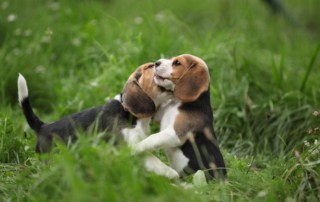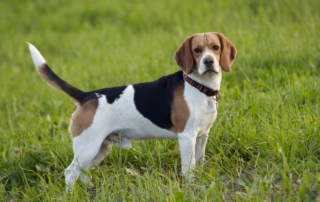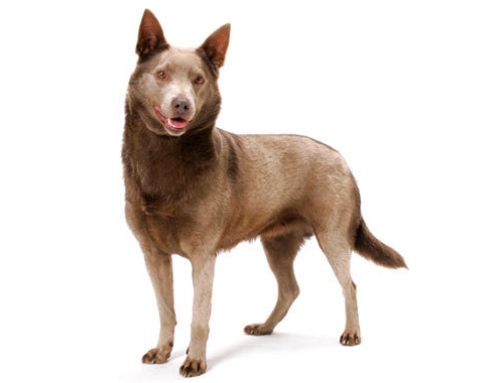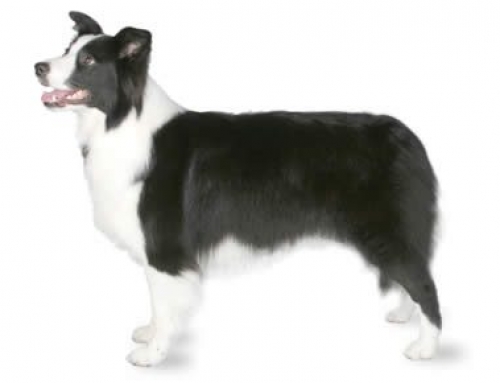Beagle
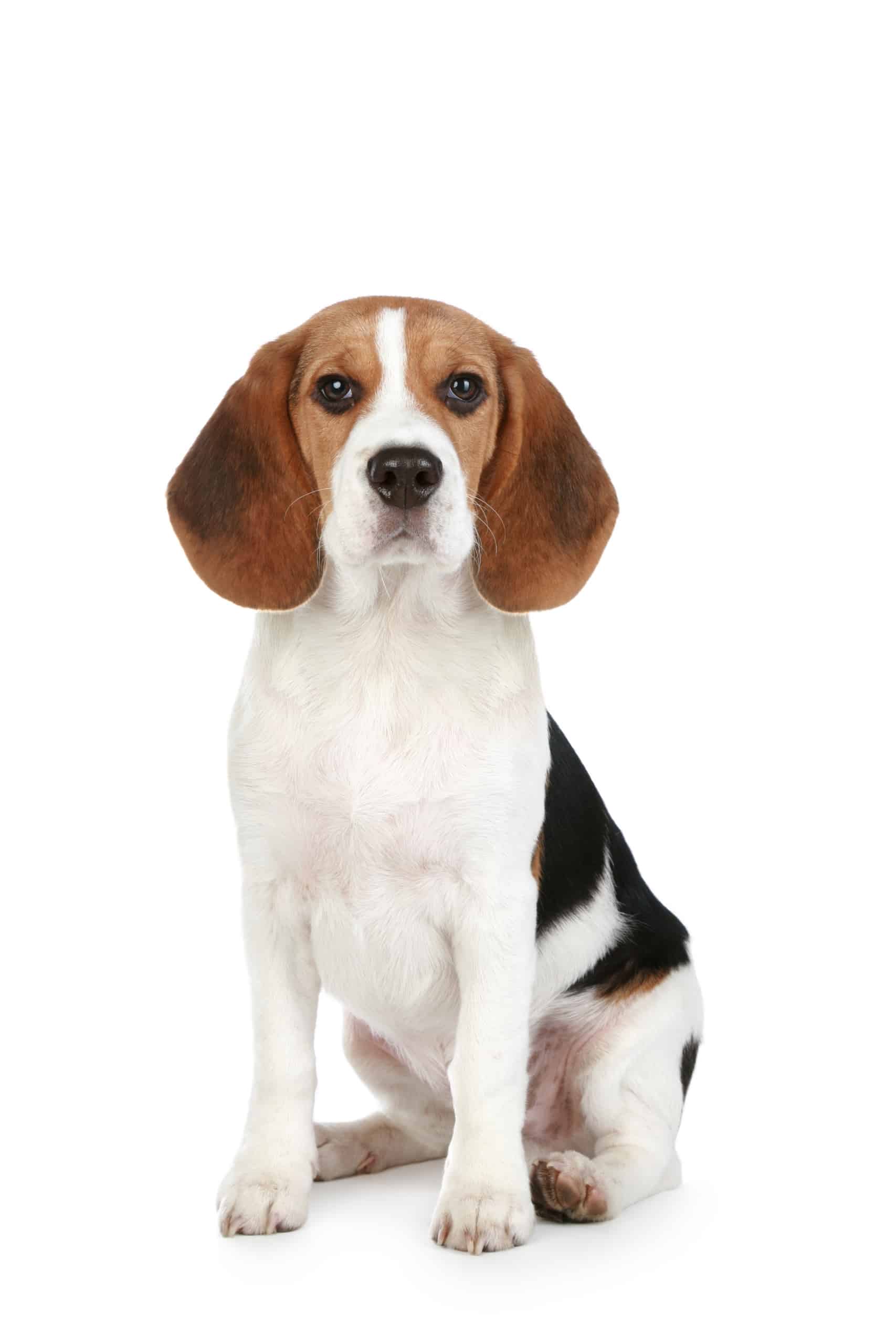
Beagle Breed Overview
Friendly, hardy, and brave, the Beagle makes for a faithful companion to his owner and family.
The Beagle’s ancestry traces back 2,500 years and the breed was designed to hunt small game. However, this scent hound’s incredible capacity to smell — the breed has roughly 220 scent receptors — means his nose is always to the ground. This talent is the primary reason why modern Beagles are found in airports around the world to sniff out contraband.
Known for his happy and outgoing behaviour, the Beagle loves to be around his people. As such, he can suffer from separation anxiety or boredom if left alone for long periods. Beagles need plenty of exercise and human interaction to stay happy and engaged. This breed can have an independent and stubborn nature at times and needs positive, consistent training from the start. Beagles are loving and gentle, and with a home full of enrichment and care, they make for wonderful family pets.
Beagles can reach 40 cm in height and 14 kg in weight.
They can live approximately up to 14 years.
Life Expectancy
The Beagle is a small dog which generally lives between 12 and 15 years, although some may live to 17 or so with proper veterinary care, diet, and genetics. As with any breed, this type of dog has a few health problems; however, the Beagle is a generally healthy breed of dog and more affordable to insure than some other breeds.
Ideally, Beagles should weigh between 8 and 14 kg. Members of this breed should fall between 33 cm and 40 cm in height at the withers.
Origin of Beagle
The Beagle has ancient roots with evidence found in Greek documents about Beagle-like dogs as far back as 400 B.C. Historians theorise that the Romans may have brought these dogs with them to England to hunt wild game and eventually bred them to native hounds. William the Conqueror brought his now-extinct Talbot hounds with him during the Conquest in 1066, and those dogs are likely the modern Beagle’s ancestors. Beagles were then bred in England because with their exceptional scent ability, they were ideal dogs for tracking and hunting fox, deer, and hares.
Although they fell out of favour as hunting dogs in 1700s England — the foxhound became the hunting dog of choice — the Beagle regained its status in the 1800s when it was bred for both its hunting skills and its attractiveness. During this era, Americans began to import the Beagles from England to breed with their own Beagles to improve the dogs’ looks. American breeders bred their Beagles to be smaller for rabbit hunting, and in 1884, the newly-founded American Kennel Club began registering Beagles. The first Beagle speciality club was also created at this time.
By the 1900s, Beagles had become one of the most popular breeds in America both for hunting and for family companionship. In 1928, the breed began to win prizes in the Westminster Kennel Club show. Since that time, the Beagle has been ranked amongst the top ten favourite breeds in America and currently holds the number three position.
Of interesting note is the origin of the name “beagle.” It may have derived from the French term begueule which means “open throat” and “mouth” or the term beugler which means “to bellow.” Either term would certainly describe this breed’s loud baying. Other possible origins include from the German word begle, “to scold,” or the Gaelic word beag, for “small.”
Beagle Temperament
Even-tempered and gentle, the Beagle is a trustworthy and reliable breed, and as such, is a popular choice for families. Although this type of dog can be shy at first with strangers, he warms up quickly to new friends when he has had time to know them. Known for their friendliness, the Beagle is a dog that brings a smile to everyone’s face.
Beagles are loyal, family-oriented dogs with an excellent temperament, but they can become bored and lonely if left home alone for long periods. As a hound, this breed is prone to howling, or baying, when alone and not occupied. This breed can also become destructive to relieve boredom by scratching and chewing items around the house. The Beagle might not be the best choice for an owner or family who is rarely at home.
Although Beagles are smart, they can become easily distracted by their superior noses. They can become stubborn and single-minded when they pick up a scent. Obedience training combined with the Beagle’s natural desire to please his owner can alleviate this issue.
Coat and Grooming
There are a variety of different colours and patterns for the Beagle. The most common colour is the tricolour, a combination of black, white, and tan. Other colours include three pied colours (hare, lemon, and badger), and white combined with red, black, or tan. All of these colours may appear as mottled as well, and all should have a white tip at the end of their tail; this last trait was so that hunters could see their dogs moving through fields. Some Beagles may also be all white.
Short and dense, the Beagle’s coat is a smooth, waterproof double coat. Beagle dog breed is prone to shedding, although it is not as noticeable because the fur is so short. Springtime is the heaviest shedding season for the Beagle, and owners should plan to brush their dog weekly to loosen and remove dead hair.
Children and Other Pets
The Beagles is renowned for his love for children, which is a primary reason why this breed is a family favourite. Although this breed is wonderful around small children, it’s important to understand that a younger Beagle can be excitable at times and should be properly trained and socialised. Be sure to supervise all interactions between your dog and your children, especially as Beagles can be mouthy during play and may grab your child’s hand if not trained correctly.
Beagles are not loners and often benefit from having another dog or a cat in the household for company. They are not the best dogs to live with small animals such as rabbits, guinea pigs, and ferrets due to the Beagle’s heritable prey drive.
General Exercise and Care
Beagles are highly intelligent dogs who can become easily distracted, most often by their noses. This breed can be led astray by their own curiosity and incredibly sensitive nose; therefore, Beagles are best living on properties with fenced backyards which can limit their wandering tendencies. Known for an uncanny ability to escape, a Beagle should be micro-chipped and wear identification tags at all times. Electronic and invisible fences are unlikely to have much impact on a Beagle who will exchange a quick shock of walking off the property for the chance at finding out where a scent leads him.
Beagles are full of energy, especially when they are young, and they require daily exercise to stay happy and healthy. Because they are intelligent, Beagles need as much mental stimulation as they do physical exercise. Walking with the family, training in the backyard, or spending time at a dog park are excellent means to wear out your Beagle mentally and physically.
Positive reinforcement and consistent obedience training will result in a dog who listens and responds to your voice. A Beagle will shut down if spoken to or treated harshly; therefore, it’s best to train your dog using beneficial methods. Beagles are especially food-oriented, and food-based reward training can work for many of them.
The Beagle can become lazy and docile as he matures, and can rapidly gain weight. As this breed is prone to obesity, do everything you can to keep your Beagle fit and healthy as he ages.
Beagles have drop-ears, thus they are more prone to ear infections as air is unable to circulate well through the ears. Their ears should be checked at least once every two weeks and gently cleaned of wax buildup on a regular basis.
Common Diseases and Conditions
Beagles are no different than any other dog breed in terms of heritable health conditions and concerns. Some dogs will develop these problems, but not all. Regardless, a Beagle owner should be aware of the diseases and illnesses that may affect their pet. Beagle puppies are a popular type of dogs bred by dog breeders in Australia; therefore, it’s important that beagle pups are purchased from a respectable and reputable beagle breeder. Creditable breeders will willingly provide health certificates and paperwork proving that the beagle puppy is medically cleared from certain genetic and inherited conditions.
These are some of the most common health problems found in the Beagle:
- Patellar Luxation, also known as “slipped stifles,” happens when the three parts of the patella — the femur, knee cap, and tibia — do not properly line up together. The result is an abnormal gait and lameness; the dog often looks bowlegged in appearance. When these three parts rub together over time, the result is often degenerative arthritis, a painful and debilitating condition. Severe patellar luxation may require surgery to give the Beagle a comfortable quality of life.
- Inter-vertebral Disk Disease happens when the disks that act as shock absorbs between the vertebrae along the spinal cord lose their jeloy-like cushioning and press against the spinal cord. Minimal compression of the spinal cord may result in mild back or neck pain, while more severe pressure can cause serious conditions such as numbness, paralysis, and lack of bowel or bladder control. In some cases, the damage done by disk disease is irreversible. Treatment with pain medications, physical therapy, and surgery may be necessary, although surgery is not always successful.
- Eye Problems are a frequent issue for Beagles. Here are some conditions known to afflict this breed:
- Cherry Eye (glandular hypertrophy) occurs when the gland under the dog’s third eyelid slips, becomes enlarged, then prolapses. The result is watery eyes and a pink or red blob in the corner of the eye (“the cherry”). The condition is treatable, although in severe cases, a veterinarian may want to remove the gland.
- Glaucoma is disease where the pressure in the eye becomes extremely high, causing damage to the optic nerve and resulting in vision loss and blindness. This painful condition can be either primary glaucoma, a hereditary disease, or secondary glaucoma, the result of an injury, tumour, or trauma. Glaucoma often affects one eye first, then the other. Surgery can be performed, however, it may not remedy the condition.
- Epilepsy affects many dog breeds, and Beagles seem amongst the most susceptible to this condition. This neurological condition is almost always inherited and may result in mild to severe seizures that are exhibited through a variety of symptoms, including circling, staggering, falling down, shaking, and losing consciousness. Epilepsy can be controlled through medications and most dogs are able to live quality lives with it.


